-
The ancient planets---Mercury, Venus, Earth, Mars, Jupiter, and Saturn---were
all discovered in prehistory---but, of course, Earth wasn't recognized
as a planet until after COPERNICUS.
- The Discovery of Uranus:
Uranus was discovered on 1781mar13 by William Herschel. See figures below (local link / general link: uranus_rings.html; local link / general link: william_herschel.html).
- The Discovery of Neptune:
In the decades after its discovery, Uranus's orbit was found to be difficult to predict.
-
Question: Why could
Uranus's orbit be difficult to predict
even when numerous observations were available.
- The 19th astronomers had a hard time doing the calculations in absence of electronic computers.
- A giant impactor disturbed Uranus's orbit in the early solar system.
- An unobserved planet beyond Uranus was perturbing its orbit.
Answer 1 is NOT right, but it is true it was pretty tedious to do multiple gravitating body calculations in the old days.Answer 2 is NOT right because the orbit one observes now is the orbit that one needs to predict. Any unknown pre-impact orbit, if there was one, is lost in the past.
Answer 3 is right.
Remember all gravitating bodies interact.
A large planet beyond Uranus would perturb its orbit and if one wants POVERBIAL ASTRONOMICAL ACCURACY, one must account for all significant perturbations.
A mathematical prediction by French and English astronomers in 1846 led to the discovery of Neptune within 1 degree of predicted location by the Berlin Observatory on 1846sep23 (No-428).
Oddly enough this discovery was partially accidental since the predicted orbit wasn't much like real orbit of Neptune (No-432).
The mathematical prediction had got the location of Neptune in space for the time more or less right, but NOT its long-term behavior.
-
Galileo had observed Neptune
from 1612dec to 1613jan as a
background object while observing Jupiter and Jupiter's moons.
Potentially, he could have recognized it as a planet since it
did move slightly over that time relative to the fixed stars.
But, in fact, he didn't. See Kowal, C. T., & Drake, S. 1980,
Nature, 287, 311.
- Planet X:
The discovery of Neptune and continuing small difficulties in exactly predicting the orbits of Uranus and Neptune (???) stimulated the search for another perturbing planet: Planet X. Percival Lowell (1855--1916) was one of the most avid searchers for Planet X (see the figure below (local link / general link: percival_lowell_planet_x.html).
- The Discovery of Pluto:
Instead of Planet X, we discovered Pluto. For who and how, see the two figures below (local link / general link: clyde_tombaugh.html; local link / general link: blink_insert.html).
No space probe has ever been there: the Pioneer and Voyager probes missed it on there way out of the solar system. So there are no close-up pretty pictures.
Only a few facts about Pluto were discovered before the 1975.
The amount of light it reflected showed early on that it was a very small object: much smaller than Uranus and Neptune, and so Pluto is NOT a gas giant.
Pluto rotation period was 6.39 days as was discovered in 1955 by studying variations in Pluto's reflected light.
-
This discovery was by Merle F. Walker and Robert Hardie of
Lowell Observatory
(Walker, M. F., & Hardie, R. 1955, PASP, 67, 224).
Hardie would later work at Vanderbilt University and overlap with Doug Hall who yours truly would overlap with at Vanderbilt in 1995--1996.
CHARON in Greek mythology is the ferryman who rows the dead over the River Styx to the Underworld.
-
Charon also turns up in Dante's Inferno
-
... And lo! toward us in a bark
Comes on an old man hoary white with eld,
Crying, "Woe to you wicked spirits! hope NOT
Ever to see the sky again. I come
To take you to the other shore across,
Into eternal darkness, there to dwell
In fierce heat and in ice.
-
---Dante Inferno, transl. H. F. Cary
(
Project Gutenberg's Dante's Inferno).
- The Discovery of Neptune:
-
Although there are no close up images of the
Pluto-Charon system,
orbital parameters, distant images, and spectroscopy allow some
information about the system to be deduced.
- The diameter of Charon is about 1/2 of Pluto's.
- The semi-major axis of the Charon orbit is only 16.4 Pluto radii.
The corresponding numbers for the Earth-Moon system are 1/4 and 60 recall. The Earth-Moon system is thus a distant second in the double planet race.
- Charon somehow formed without those molecules.
- They escaped from the Charon more easily because of its lower gravity.
- It is a heavier molecule than N_2 and CH_4.
- It H_2O doesn't sublime below a temperature about 200 K and the sublimation temperatures of N_2 and CH_4 are much lower
Pluto and Charon
______________________________________________________________________________
Quantity Value
_______________________________________________________________________________
Mean distance from the Sun 39.48168677 astronomical units
Eccentricity of orbit 0.24880766 : this is the largest in the
solar system for a planet.
Mean inclination to Ecliptic 17.14175 degrees : also the largest in the
solar system for a planet.
Axis tilt to orbital north pole 119.61 degrees : This means that
the reference rotation
is clockwise??? in a crude sense
around the orbital north pole.
Orbital period 248.0208 years : it hasn't completed 1/3 of
its orbit since discovery.
Rotational Period 6.38725 days : the rotation is retrograde:
(both bodies: i.e., it is clockwise-ish as
they are mutually viewed from the orbital north
synchronously tidally locked.) pole.
Charon revolution period 6.38725 days : the same as the rotation periods
due to synchronous tidal locking.
Each body
hovers at the same point in the
other's sky.
Charon semi-major axis 1.96 x 10**4 km = 3.07 Earth radii = 16.4 Pluto radii
Pluto equatorial radius 1195 km = 0.180 Earth radii:
Pluto is only the 12th largest
rocky-icy bodies in the solar
system: it is smaller than
the Moon and the Galilean
satellites.
Charon equatorial radius 593 km = 0.0930 Earth radii = 0.496 Pluto radii
Pluto mass 1.3 x 10**22 kg = 0.002200 Earth masses :
Pluto is by far the least
massive planet: Mercury is next
with 0.055274 Earth masses.
Charon mass 1.62 x 10**21 kg = 0.00027 Earth masses
= 0.125 Pluto masses
Pluto & Charon mean density about 2 g/cm**3 : recall water density
is 1 g/cm**3 and silicates
have about 3 g/cm**3
Pluto and Charon may a 50-50
mixture of rock and water ice.
But the densities are NOT
well determined it seems:
which means the masses and/or
radii arn't either.
Probably the radii since the
orbits should give masses
pretty well.
Pluto surface temperature about 50 to 60 K varying from aphelion to
perihelion.
_______________________________________________________________________________
References: Cox-294--297, 302--308; SRJ-233; FMW-239.
_______________________________________________________________________________
From the above numbers one can see that the Pluto-Charon system is the closest the solar system has to a double planet.
The double planet nature is illustated in the figure below.
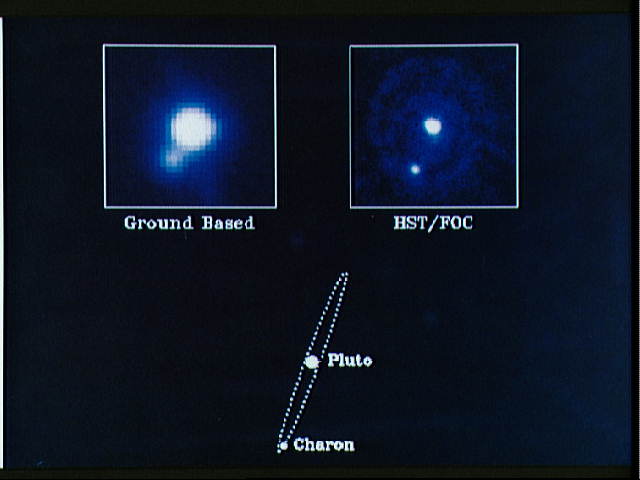
Caption: Pluto and its satellite Charon from the ground and the HST.
The image at the upper right was the first long-exposure HST image of a target moving with respect to the fixed stars. It was taken 1990oct23.
The ground-based image in the upper left is from the Canada-France-Hawaii Telescope on Mauna Kea in Hawaii. It has about the best resolution from the ground available in 1990.
The diagram at the bottom shows the Charon's orbit in the same orientation as in the images (HI-239).
Pluto's equatorial radius is 1195 km (0.180 Earth radii); Charon's radius is 593 km; Charon's mean distance from Pluto is 19,600 km (3.07 Earth radii) (Cox-295, 305, 306).
Credit/Permission: NASA,
HST,
before or circa 2005 /
Public domain.
Download site:
NASA/HST: photoId=S90-50868.
Alas, a dead link.
Image link: Itself.
Spectroscopy tells us that the surface of Pluto is mostly Ni_2 ice with a few percent methane (CH_4), carbon monoxide (CO), and ethane (C_2H_6) (HI-239).
Pluto does have thin atmosphere which is mainly N_2 and methane that probably comes from evaporation from the surface during the near perihelion phase (FMW-239). The last exact perihelion was 1989sep05 (Cox-295).
This atmosphere may recondense as Pluto draws away from the Sun.
The pressure of the atmosphere is only of order 10**(-5) of Earth's.
Pluto looks reddish. This may be caused by compounds created from methane ice by sunlight (Se-547).
The surface features of Pluto can be marginally resolved using the HST and computer processing as illustrated in the figure below.
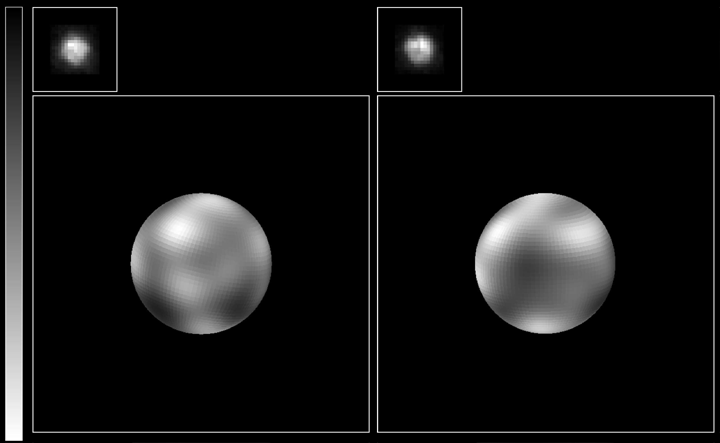
Caption: Resolved images of Pluto from the HST, 1994jun/jul.
These images show the first resolved surface features on Pluto. The two images show opposite hemispheres with north up. The small images are the top are the raw images before processing.
Pluto has a diameter of 2390 km and the pixel size is 150 km.
The color variations are probably caused by topographic features and/or surface composition. Pluto is mostly covered by nitrogen ice (N_2 ice which requires temperatures below about 63.25 K (HI-239; CAC-54). The surface temperature ranges from about 60 K at perihelion to 50 K at perihelion (FMW-238).
The surface may interact with the atmosphere which is mainly N_2 with perhaps some methane (PF-156).
The atmosphere may freeze out circa 2010--2020 when Pluto moves farther from the Sun (PF-156). Pluto is at its warmest near perihelion which occurred 1989sep05 (Cox-295).
Credit/Permission: NASA,
HST,
1994 /
Public domain.
Download site:
NASA/HST: NASA Image ID number: STScI-PR96-09A.
Image link: Itself.
Oddly, Charon's surface is different from Pluto's.
It seems to be all water ice and dark material: some kind of soil: perhaps carbonaceous regolith??? (HI-240).
-
Question: What could explain the absence of N_2 and CH_4 on
Charon when they are found on Pluto?
Answers 1 and 2 both seem right as possibilities to me, but
no one knows for sure
(HI-240).
-
Question: Assuming N_2 and CH_4 escaped from Charon,
why might H_2O NOT have escaped?
(Note the pressure of any atmosphere on Charon is almost certainly so low that the liquid phases of most substances probably CANNOT exist. The solid phase sublimes directly to the gas phase.)
Answer 2 is possibly right.
The sublimation temperatures of CH_4 and N_2 must be about 89 K and 63 K, respectively (CAC-54; see also the Ni_2 phase diagram at Ana' Larsen's Planetary Surfaces Fundamentals: Reflectance, Density, and Phases ). Water under low pressure sublimes at about 200 K ( Water Phase Diagram).
I don't think answer 1 can be right.
The atomic weight of CH_4 is 16 which is only marginally less than H_2O's 18. N_2 has atomic weight 28 and so is heavier than H_2O.
Well just as with the Earth-Moon system, a giant impactor may have collided with Pluto and mostly merged with it, but ejected material some of which coalesced into Charon (HI-239).
But we know far less about the Pluto-Charon system than about the Earth-Moon system, and so ideas might change.
As for the origin of Pluto itself? We will take that up below when we consider rocky-icy bodies in general.
-
There is no precise definition of a planet.
Commonly, a planet is larger body that orbits the Sun (or any star) and asteroids and smaller rocky-icy bodies---a term I use for the lack of any better one---are smaller bodies or, maybe, planetoids.
Well PLUTO kind of straddles the line as the line now appears as illustrated in the figure below (local link / general link: rocky_icy_body.html).
References:
(Cox-295,305,306;
HI-161;
David Jewitt's Kuiper Belt site).
PLUTO is only the 12th largest rocky-icy bodies in the solar system.
It is smaller than many of the larger moons, including the Earth's moon (i.e., the Moon).
But it is larger than any of the other rocky-icy bodies that orbit the Sun including the trans-Neptunian objects (TNOs) Sedna, Orcus (AKA 2004 DW), Quaoar (pronounced kwah-o-wahr), and Ixion.
-
[Trans-Neptunian objects seem to be loosely defined as any object
whose orbit is entirely or mostly beyond the orbit of Neptune
(
Wikipedia: Trans-Neptunian Objects)
Neptune's orbit has a semi-major of 30.06896348. The eccentricity is quite small: 0.00858587 which is only about half the eccentricity of Earth's orbit. Neptune's orbit is very circular.]
So size-wise, PLUTO could go either way.
But as a physical object PLUTO is probably the same in nature and origin to the other TNOs that we will discuss below.
PLUTO is only distinguished by its size and its early discovery (i.e., 1930).
But traditionally PLUTO is classed as a planet and the International Astronomical Union (IAU) asserted in 1999 that PLUTO would continue to be a planet (PF-158).
But larger TNOs than PLUTO may be discovered someday---maybe even someday soon---and then the status of PLUTO will probably be debated again.
-
COMETS are icy/rocky bodies on highly elliptical orbits that plunge
into the inner solar system from the outer solar system.
Their ices evaporate somewhat explosively as they approach the Sun which leads to them being bright, large, ``long-haired'' objects: the name comet is from the Greek kometes meaning long-haired (Ba-241).
Because they lose volatile material every time they enter the inner solar system, COMETS CANNOT live forever.
They may last only a thousand orbits: i.e., a thousand perihelions (Se-569)
Assuming they do NOT hit a planet or even the Sun (Se-568), COMETS become dead rocks probably with carbonaceous material (Se-568) without volatiles or break-up altogether.
The dead comets too can hit planets and probably end up doing so at some point since they keep crossing planet orbits.
Debris from live or dead COMETS can become path of small particles that hit the Earth as METEORS in a METEOR SHOWER when the Earth passes through the path (Se-553).
Since COMETS do NOT live forever, they must be resupplied in order to still have them so long after the formation of the solar system.
There are two classes of COMETS: short-period and long-period.
The short-period COMETS have orbital periods of less than 200 years and their orbital inclinations tend to lie within 30 degrees of the ECLIPTIC PLANE (Se-569).
In the 1940s and 1950s, Edgeworth and Kuiper (pronounced koyper) proposed that there must be a belt of rocky-icy bodies beyond about Neptune to resupply the short-period COMETS (HI_249; PF-157).
Perturbations from the outer planets and, perhaps, collisions??? occasionally causes one of these rocky-icy bodies to go onto a plunging orbit and become a short-period COMETS (HI_249).
The KUIPER BELT (as it is now called) is thought to extend from about 30 to 100 AU from the Sun and be about 10 AU thick (HI_249; PF-157).
The Kuiper belt objects were probably created in situ. They are icy/rocky planetesimals or protoplanets or fragments thereof that were never accreted into larger bodies for some reason (HI_249).
Until 1992, the KUIPER BELT was entirely theoretical unless one counts Pluto and Charon as Kuiper belt objects (KBOs) as we now do, but we didn't do then.
KBOs are also called TRANSNEPTUNIAN OBJECTS (TNOs) since the orbital semi-major axis of Neptune is 30.069 AU (Cox-294). To me neither name is entirely satisfactory since there can be icy bodies that are neither KBOs of TNOs.
In 1992, David Jewitt and Jane Luu discovered the first KBO: which has the catchy name 1998 QB1.
-
Many KBOs/TNOs have discovered since 1992 by dedicated searches.
- Because they're there.
- It's sort of like stamp collecting for some folks.
- They are primitive objects, and so they and their distribution will tell us something about how the solar system and other planetary systems formed.
- The periods, except for Pluto, are rather approximate. I calculated them myself using Kepler's 3rd law.
- The Pluto and Charon diameters 2380 km and 1186 km, respectively, are given by Cox-306. Who is right?
- Orcus's provisional name was 2004 DW.
- Sedna is NOT officially a KBO since its orbit overall is too
far out. It is a TNO for sure. Sedna's perihelion and aphelion distances
are 76 AU and 990 AU, respectively.
Kepler's 3rd law gives the Sedna year as 12300 Julian years, but the NASA press release gives 10500 years and presumably NASA knows best ( NASA: Sedna press release).
As of 2004apr23, there are 786 TNOs, NOT counting Pluto, Charon, or Sedna ( Minor Planet Center list of trans-Neptunian objects). Batches of new discoveries seem to be anounced monthly or bimonthly.
Most of known KBOs are estimated to have diameters of about 100 km ( David Jewitt's Kuiper Belt Page).
But the sizes of KBOs/TNOs are very uncertain. Except for Pluto and Charon, they are NOT resolved.
The sizes must be estimated by their reflected brightness visual or thermal emission in the IR.
This estimation requires making some uncertain assumptions.
It has been estimated that that there maybe 35,000 KBOs larger than 100 km in diameter (HI-249).
-
Question: Why do we want to find KBOs/TNOs?
All answers are probably right, but answer 3 is the one you use
when you go to a funding agency like the National Science Foundation
(NSF) and ask for money to study dim points of light that can only
be observed with the biggest telescopes.
______________________________________________________________________
Largest KBOs/TNOs as of 2004apr
______________________________________________________________________
Object Diameter semi-major ecc. Incl. Year Discovery date
(km) axis (AU) (deg.) (Jyr)
______________________________________________________________________
Pluto 2320 39.4817 0.2488 17.14 248.0208 1930feb18
Orcus 1500? 39.473 0.218 20.6 248.00 2004feb17
Sedna <1500? 532. 0.857 11.9 10500. 2003nov14
Charon 1270 1978jul02
Quaoar 1200±200 43.377 0.034 8.0 285.69 2002jun04
Ixion 1065±165 39.485 0.242 19.6 248.12 2001may22
Varuna 900±140 43.129 0.051 17.2 283.24 2000nov28
2002 AW197 890±120 47.501 0.130 24.3 327.39 2002jan10
______________________________________________________________________
References: David Jewitt's Kuiper Belt Page; Minor Planet Center list of trans-Neptunian objects. Notes:
______________________________________________________________________
-
SEDNA was discovered at Palomar Observatory in California in 2003nov14,
but the discovery was only announced 2004mar15---the Ides of March.
- Yes. The Earth's average position relative to Sedna
is the position of the Sun since the Earth is orbiting the Sun
on a very short time scale compared to the time for Sedna to
come to perihelion.
So on average Sedna is getting closer to the Earth.
- No. Sedna is moving so slowly along its orbit and so slowly
in the direction of the Sun, that over the course of an
Earth year, Sedna is almost at rest compared to the Earth.
So for about half of Earth's year, Sedna is getting closer to the Earth as the Earth moves toward Sedna and for the other half of Earth's year, Sedna is getting farther from the Earth as the Earth moves away from Sedna.
- No. Like Pluto and other trans-Neptunian objects it is
by itself too small to be a significant perturber of the
orbits of Uranus and Neptune. Thus, it is
NOT
the Planet X that Lowell and so many others have sought.
- Yes. At the time of its discovery, it was probably
the largest body found in the solar system since Pluto.
Thus, it should be counted as the 10th planet: i.e., it
is Planet X.
- No. TNO Orcus (AKA 2004 DW) was discovered 2004feb17 and as far
as we can tell it is about the same size as Sedna.
It may be larger. There are may be even larger TNOs
discovered in the future.
Which one is Planet X or do we start calling all objects of order 1500 km planets?
That is just a rhetorical question. Of course, we don't.
Remember these objects are smaller than Pluto although they are larger than the largest asteroid Ceres (diameter 913 km: Cox-317).
Remember also that Sedna's diameter is very uncertain. It may be smaller than Pluto's moon Charon (diameter 1270 km) or Quaoar (diameter 1200±200 km).
-
For the discovery announcement see
NASA press release.
There is a probably more stable article at
David Jewitt's Kuiper Belt site:
Sedna.]
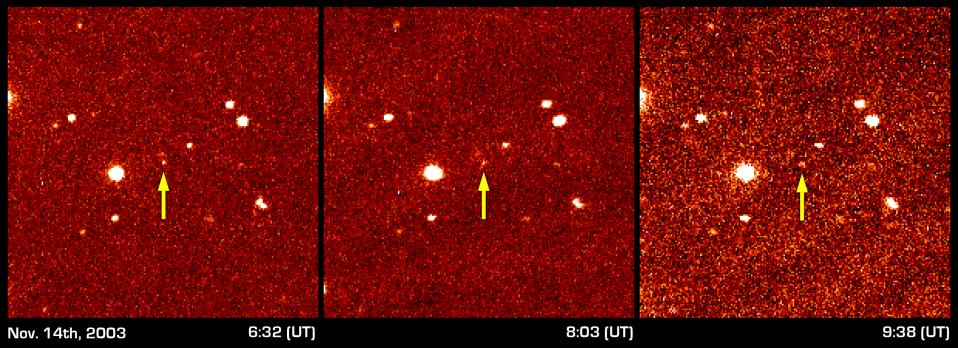 Discovery images of Sedna.
Discovery images of Sedna.
Sedna is a trans-Neptunian object discovered 2003nov14.
These images show Sedna moving against the background of the fixed stars. This shows that it is a solar system body.
It is quite large. Probably of order 1500 km in diameter, but still significantly smaller than Pluto.
Little is known about Sedna, but spectroscopy tells us that it is reddish.
Credit/Permission: NASA,
Caltech,
2004 /
Public domain.
Download site:
NASA/Caltech: Image #PIA05568.
Image link: Itself.
SEDNA has been observed also by the HST and the Spitzer Telescope which is an infrared satellite telescope.
SEDNA is NOT a KBO nor an Oort Cloud object (see the Oort Cloud section below).
It's mean distance from the Sun (532 AU) is too far out for the former and to close for the latter.
So SEDNA may need to be put in a new class of objects.
But for the nonce we can put it in the wide class of TNOs.
Sedna and Pluto are compared in the figure below.
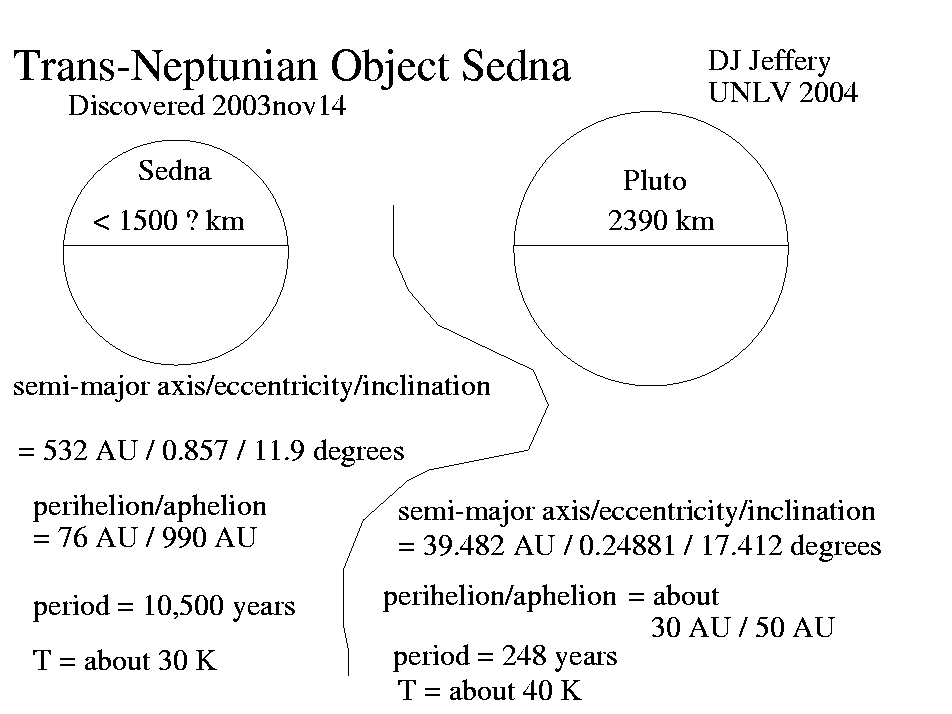
Caption: Sedna in comparison to Pluto.
Credit/Permission: ©
David Jeffery,
2004 / Own work.
Image link: Itself.
Initially, it was thought that Sedna like Pluto had a moon, because of Sedna's very slow rotation rate: about 20 days. Synchronous tidal locking with a fairly distant moon would slow Sedna down to such a long period.
But close observation reveals NO moon: maybe the moon is very dark or was eclipsed by Sedna when they looked for it or was lost in some gravitational interaction in the past.
Currently, Sedna is at about 90 AU from the Sun NASA press release.
It will get closer to the Sun for another 72 years.
-
Question: If Sedna is getting closer to the Sun, is it necessarily
getting closer to the Earth?
Some help is given by the figure below.
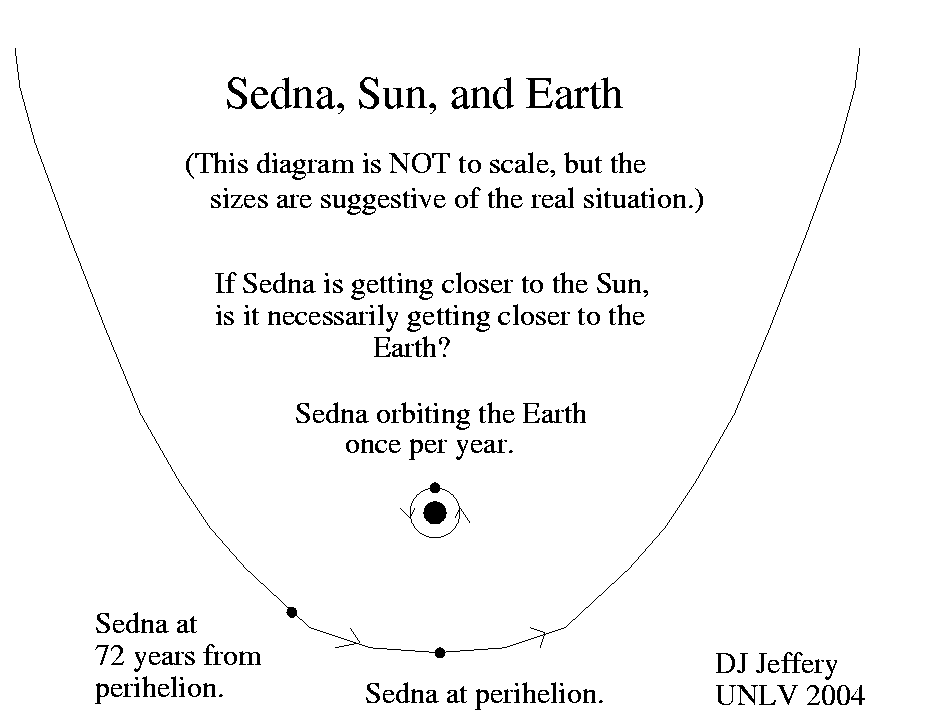
Caption: Sedna and Earth.
Credit/Permission: ©
David Jeffery,
2004 / Own work.
Image link: Itself.
Answer 2 is right I think. My sense of orbital motions and
size scales tells me this,
but I have NOT actually done a calculation.
Except for the first word ``yes,'' answer 1 is right too.
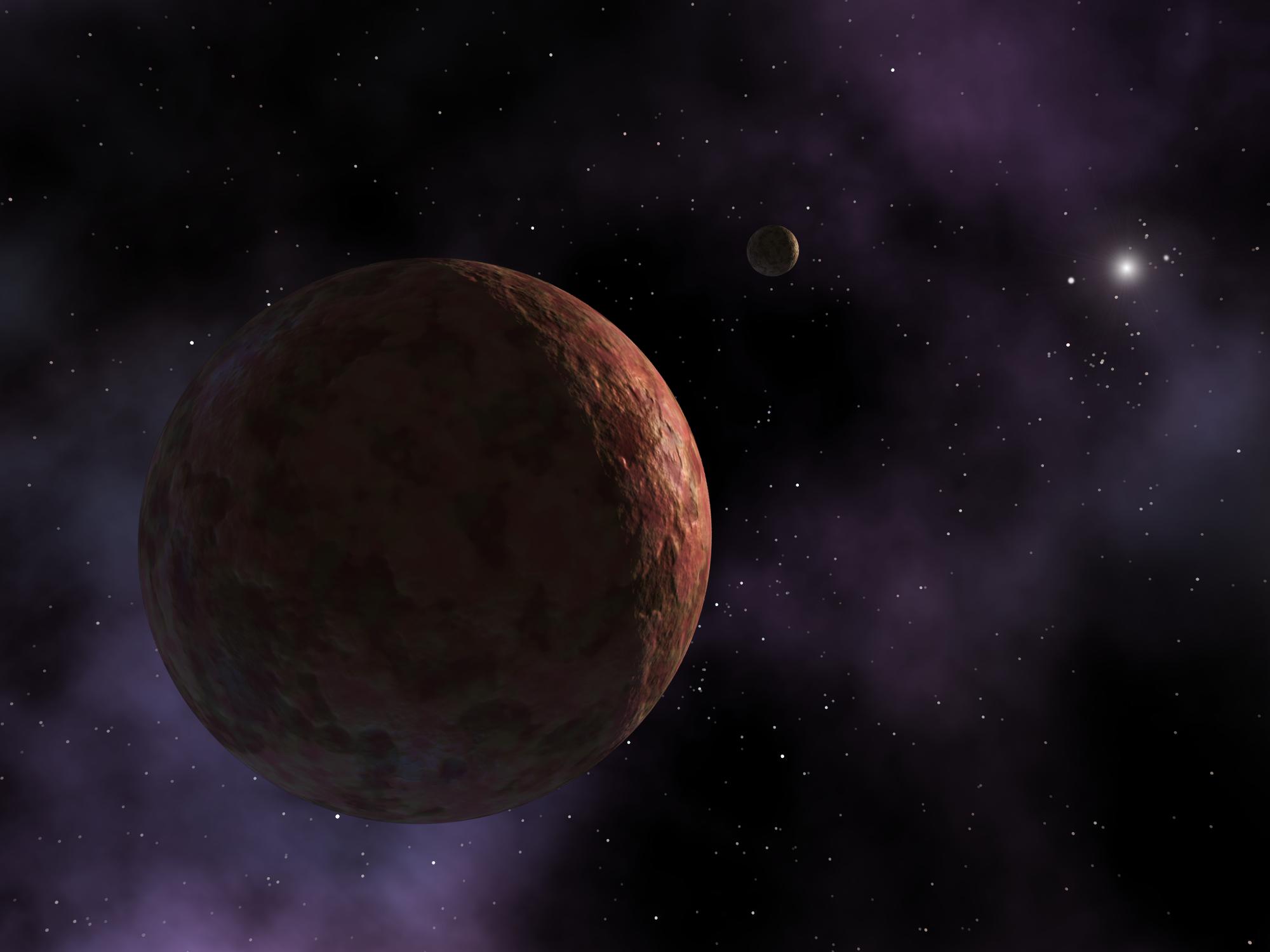
Caption: An artist's conception of Sedna from 2004.
Sedna is a trans-Neptunian object discovered 2003nov14.
It is quite large. Probably of order 1500 km in diameter, but still significantly smaller than Pluto.
Little is known about Sedna, but spectroscopy tells us that it is reddish.
From Sedna, the Sun appears as bright star and NOT a disk.
Early on there was some evidence that Sedna had a moon and the artist as put it in the image. It is the crescent.
Sedna was named for the Inuit goddess Sedna who is mistress of the undersea world and aquatic mammals, and ruler of the dead. See the Sedna Myth and Sedna in Bronze by Joan Relke. But there are thousands of Sedna sites and this is even before she had a trans-Neptunian object named after her.
Credit/Permission: R. Hurt???,
NASA,
JPL,
Caltech,
2004 /
Public domain.
Download site: R. Hurt/NASA/JPL-Caltech:
Image #PIA05566.
Image link: Itself.
-
Question: Is Sedna Planet X?
Answer 1 is right if you take Planet X to be Lowell's Planet X.
In fact, the observed orbital problems that Lowell and others tried to account with Planet X seem to be mostly errors. No Lowellian Planet X is needed.
But on the other hand if Planet X is just the next planet discovered then it depends on how you define planets.
Yours truly and probably most other astronomers use answer 3, but it is a matter of opinion.
In the future if solar system bodies larger than Pluto are found, an official rule about what constitutes a planet may evolve.
-
LONG-PERIOD COMETS have periods of order 10**6 to 10**8 years
(Se-569;
HI-248).
- A passing star's gravity can perturb some orbits into plunging orbits.
- Collisions among the Oort Cloud objects can send fragments into the inner solar system.
The longest-lived ones can outlive the solar the solar system if they can make of order 1000 orbits (Se-569).
10**8 years x 1000 = 10**11 years = 100 Gyr and the solar system is only going to live about 10 Gyr but 10**6 x 1000 = 10**9 Gyr and so the shorter-lived LONG-PERIOD COMETS must be renewed.
Another aspect about LONG-PERIOD COMETS is that they can plunge on their highly elliptical orbits from from any direction.
LONG-PERIOD COMETS are NOT confined to being near the Ecliptic Plane like short-period comets. See the figure below (local link / general link: comet_orbits.html).
These long-period comet facts led Dutch astronomer
Jan Oort (1900--1992)
in 1950 to propose a spherical reservoir of
rocky-icy bodies
extending from about 50,000 AU to 200,000 AU from the Sun
(see Wikipedia: Jan Oort:
A few of Oort's discoveries).
This reservoir has come to be called the Oort cloud---which is not a very good name since it is NOT a cloud---it is more of swarm.
-
By the by, my old colleague UNLV astronomy professor George Rhee was
a graduate student of Oort in the 1980s when Oort was still
very active.
But answer 2 should work to if collisions are frequent enough.
Question: What causes an Oort Cloud object to go
onto a plunging elliptical orbit into the inner solar system?
Answer 1 is the answer in the texts
(Se-569)
and so I assume it must
be the main process.
-
The CENTAURS are smaller grouping of
rocky-icy bodies/comets
whose orbits cross those of the
gas giants.
They are named CENTAURS are named after the prototype object Chiron, which was named after a centaur (HI-249).
The Chiron was first identified as an asteroid (i.e., a rocky body), but then started showing cometary behavior: i.e., it started outgassing and developed a comet head. It was clearly an rocky-icy bodies.
It has been estimated that of order 2500 centaurs of diameter scale a 75 km may exist (HI-249).
There were 7 as of 2000 (Cox-327).
The Minor Planet Center lists 149 Centaurs and scatterd-disk objects has of 2004apr25 ( Minor Planet Center list of trans-Neptunian objects). But they don't say which are which.
Centaur orbits are unstable due to gravitational perturbations of the gas giants and they may only survive a few million years before they collide with something or are ejected (HI-249).
Centaurs may have originated in the Kuiper Belt and have been kicked inward into the gas giant range by gravitational collisions or the perturbation of passing stars.